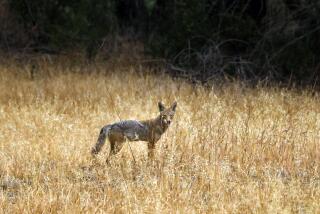
- Share via
- Those behind the new study note that previous research has found that more affluent areas may harbor more negative views toward coyotes.
- It’s one of several surprising findings in the paper exploring the impact of societal wealth and ecological health on the polarizing animal’s movement.
Lush greenery and abundant wildlife — attributes of many affluent L.A. neighborhoods that lure people — would seemingly be draws for predators like coyotes too.
But a new study found coyotes were less inclined to seek out higher-income areas in their home ranges, preferring to stick to less-wealthy parts, surprising researchers.
While affluent ZIP Codes may have more wild prey and places of refuge, the people who live in those areas “also tend to harbor more unfavorable and separationist views on coyotes,” according to the study from UC Berkeley and UC Agriculture and Natural Resources, positing a possible explanation.
People in affluent neighborhoods have shown heightened support for killing the animals and hazing is more common in wealthy areas, reports the study that was published Tuesday in the journal “Ecology Letters.”

Researchers cited several studies to support the idea that people in affluent areas may view coyotes differently, including one from last year that used fieldwork in L.A. and conversations collected from the online application Nextdoor to theorize about how internet discourse on the animals leads to real-world ramifications “in the increasingly contentious coyote debates” in L.A. and elsewhere.
Another study cited from 2023 analyzing a decade of coyote reports in San Francisco found that higher median income was correlated with with negative opinions of the polarizing animals.
Some means of getting rid of coyotes, like trapping, can be costly, according to the new study.
“In the less-resourced areas, people aren’t hiring trappers as much as in the wealthier areas,” said Christine Wilkinson, lead author of the study and a recent postdoctoral researcher at UC Berkeley. “So we’re kind of wondering, is that because these are places coyotes are aware of removal? Or aware of these threats?”
The finding is among several results researchers say were unexpected from the paper exploring the impacts of societal wealth and ecological health on the canids’ movement using tracking data from 20 coyotes primarily roaming in Los Angeles County. Researchers behind the new study say the takeaways can help guide urban planners and conservationists in building wildlife-friendly cities.
The study joins a growing body of research focused on how societal factors shape animal behavior, an approach that some believe provides more accurate insights than exploring ecological factors alone.
A war on urban coyotes is exposing deep divisions between those who want to eradicate the animal and those who are calling for peaceful coexistence.
Coyotes tracked in the study had larger home ranges in areas with more pollution, higher population density and lower income compared with those in areas the researchers describe as less burdened. Researchers said it appeared the animals, known for resiliency, traveled farther afield to get what they need — likely expending more energy along the way.
Coyotes in more polluted and densely populated areas were also more likely to venture into city parks, suggesting they may be risking human interaction for grub and potentially spots to den because their pickings are slim, researchers said.
Urban parks can offer a steady stream of trash and rats that are attracted to that trash, Wilkinson noted.
Meanwhile, the study found that coyotes throughout the county were less interested in cemeteries and golf courses, which are often identified as important places for wildlife in urban ecology literature, according to Wilkinson. In those places, trash is routinely picked up and vegetation might be cut in a way to reduce hiding spots, she said, suggesting a potential explanation for the finding.
“Coyotes are one of the most adaptable carnivores, but their movement patterns really reflect broader urban inequities,” said Wilkinson, now a research associate with the California Academy of Sciences in San Francisco. “So I think we can use coyotes as a lens for thinking about how we can make cities better for both people and wildlife.”
Movement data from the study came from 20 coyotes — six females and 14 males — that were outfitted with satellite tracking collars for another study that never came to fruition.
The main method employed to see where the mesopredators were choosing to go compared actual location points gleaned from their collars to a random set of points in their home range. The broad picture of what they were doing was broken down further by levels of pollution, wealth, population density and other variables.
“We took all 20 of our coyotes and we looked at who has a pollution burden above the mean pollution burden for these coyotes and who has a pollution burden below, and we compared what they were doing differently within their home ranges,” Wilkinson said, providing an example.

Researchers also examined how fast the coyotes moved as well as turn angles to provide a sense of their fine-scale movement across the landscape in addition to their overall habitat preferences.
The size of the home range — which was defined as where the coyotes spent 95% of their time — varied significantly between animals. One female had a home range that was less than a square kilometer, while another female’s range straddling L.A. and San Bernardino counties spanned 114 square kilometers.
Niamh Quinn, human-wildlife interactions advisor at UC Agriculture and Natural Resources and study co-author, said the study findings underscore the need to start looking at wildlife in different ways.
Many movement studies look only at ecological factors, but people and animals are affected by the same things, she said.
“People are affected by unhealthy communities, and it seems like coyotes potentially may also [be],” she said.
There are also some potential practical ramifications. Residents living in more polluted neighborhoods may need to take more precautions for keeping their pets safe, Quinn said.
Cats, rats and rabbits are believed to be coyotes’ preferred mammalian prey, she said.
L.A. County is full of coyotes. Knowing what to do when you see one will better keep you, your pets and the coyote safe from harm.
While the study focused on where the coyotes did and didn’t go, Quinn said coyotes are practically everywhere in L.A. County. More reports of coyote activity come from wealthy areas, but those reports aren’t necessarily indicative of their population level there, she said.
“We have parts of the city of L.A. that have absolutely no reports, and it’s not because there are not coyotes there,” she said. “It’s because the people there have other things to think about.”
The prevalence of coyotes means Angelenos are bound to run into them — whether it’s during a hike in Griffith Park or a stroll through East Hollywood. They tend to elicit strong emotions, Quinn said, loosely categorized as love or hate. Conflict between humans and the wild canids is difficult to manage, she said.
Sometimes the tensions pit humans against one another, too.
Last year, California wildlife officials investigated a coyote trapper employed by Torrance and other cities for possible violation of state law at the urging of animal welfare activists.
Trapping and killing coyotes in urban settings is contentious but not uncommon.
People for the Ethical Treatment of Animals, which set the investigation in motion, has also petitioned for statewide regulations that would ban gassing coyotes and prohibit cities from contracting with private trappers who work on public land.









